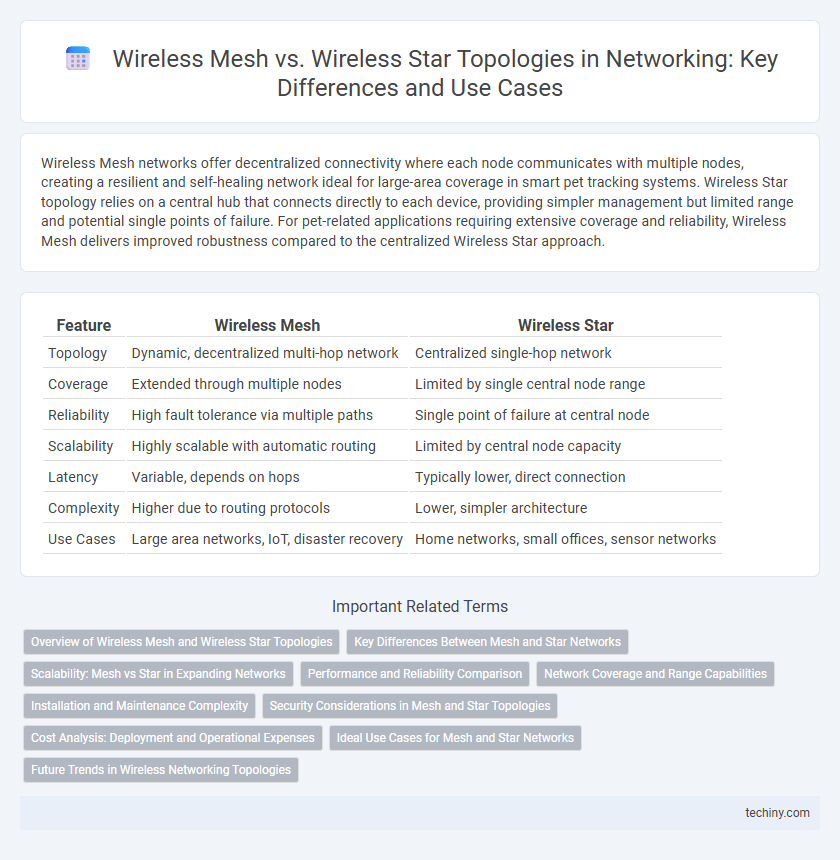Wireless Mesh networks offer decentralized connectivity where each node communicates with multiple nodes, creating a resilient and self-healing network ideal for large-area coverage in smart pet tracking systems. Wireless Star topology relies on a central hub that connects directly to each device, providing simpler management but limited range and potential single points of failure. For pet-related applications requiring extensive coverage and reliability, Wireless Mesh delivers improved robustness compared to the centralized Wireless Star approach.
Table of Comparison
| Feature | Wireless Mesh | Wireless Star |
|---|---|---|
| Topology | Dynamic, decentralized multi-hop network | Centralized single-hop network |
| Coverage | Extended through multiple nodes | Limited by single central node range |
| Reliability | High fault tolerance via multiple paths | Single point of failure at central node |
| Scalability | Highly scalable with automatic routing | Limited by central node capacity |
| Latency | Variable, depends on hops | Typically lower, direct connection |
| Complexity | Higher due to routing protocols | Lower, simpler architecture |
| Use Cases | Large area networks, IoT, disaster recovery | Home networks, small offices, sensor networks |
Overview of Wireless Mesh and Wireless Star Topologies
Wireless Mesh topology consists of interconnected nodes that dynamically route data through multiple paths, enhancing network reliability and coverage in large or complex environments. Wireless Star topology centers communication around a single central hub or access point, optimizing simplicity and ease of management for smaller networks with predictable traffic patterns. Both topologies offer distinct advantages depending on network size, scalability, and redundancy requirements.
Key Differences Between Mesh and Star Networks
Wireless mesh networks feature multiple interconnected nodes that create a decentralized structure, enhancing redundancy and self-healing capabilities. Wireless star networks rely on a central hub connecting all devices, which simplifies management but creates a single point of failure. Mesh networks provide greater coverage and reliability for dynamic environments, whereas star networks optimize for straightforward deployment and ease of control in smaller setups.
Scalability: Mesh vs Star in Expanding Networks
Wireless mesh networks offer superior scalability compared to wireless star networks by enabling direct device-to-device communication that automatically reroutes data through multiple paths. This decentralized structure supports seamless integration of new nodes without significant performance degradation or increased bottlenecks. In contrast, wireless star networks rely heavily on a central hub that can become a scalability bottleneck as the number of connected devices grows, limiting network expansion and resilience.
Performance and Reliability Comparison
Wireless mesh networks distribute data across multiple nodes, enhancing reliability through dynamic routing and self-healing capabilities, which minimizes downtime during node failures. In contrast, wireless star networks rely on a central hub, creating a single point of failure that can reduce overall network reliability but offers lower latency in straightforward communication scenarios. Performance in wireless mesh networks excels in scalability and coverage, while wireless star networks typically provide faster data transmission speeds in smaller, less complex environments.
Network Coverage and Range Capabilities
Wireless Mesh networks provide extensive coverage through interconnected nodes that dynamically route data, enabling scalable and resilient communication across large areas. Wireless Star topology relies on a central hub, limiting range and creating single points of failure, which restricts coverage to the hub's transmission radius. Mesh topology excels in range capabilities by leveraging multiple paths and self-healing features, ideal for wide, complex environments.
Installation and Maintenance Complexity
Wireless Mesh networks feature decentralized nodes that self-configure and dynamically route data, reducing installation complexity by eliminating the need for a central hub. Maintenance in mesh systems can be more straightforward due to automatic rerouting and self-healing capabilities, minimizing downtime. In contrast, Wireless Star topologies require centralized access points, making initial installation simpler but increasing maintenance challenges, as failures in the central node can disrupt the entire network.
Security Considerations in Mesh and Star Topologies
Wireless mesh networks offer enhanced security through their decentralized architecture, reducing single points of failure and enabling dynamic path selection that mitigates targeted attacks. In contrast, wireless star topologies rely heavily on a central hub, making it a critical vulnerability and attractive target for attackers seeking to disrupt the entire network. Mesh networks support robust encryption and authentication protocols across multiple nodes, providing distributed defense mechanisms that improve resilience and integrity compared to the centralized security framework of star networks.
Cost Analysis: Deployment and Operational Expenses
Wireless mesh networks generally incur higher deployment costs due to the need for multiple interconnected nodes, but they reduce operational expenses through self-healing and dynamic routing capabilities that minimize maintenance. Wireless star topology features lower initial setup expenses with a centralized access point, yet operational costs can rise from potential single points of failure and increased management overhead. Evaluating total cost of ownership reveals that wireless mesh is more cost-effective in large, scalable networks, while wireless star suits smaller, simpler deployments with limited budget.
Ideal Use Cases for Mesh and Star Networks
Wireless mesh networks excel in large-scale, dynamic environments such as smart cities, industrial automation, and disaster recovery due to their decentralized architecture, which ensures robust coverage and self-healing capabilities. Wireless star networks are ideal for smaller, static setups like home automation or small office environments where centralized control and straightforward device management are essential. Mesh networks support extensive scalability and high fault tolerance, while star networks offer simplicity and lower latency in applications with limited nodes.
Future Trends in Wireless Networking Topologies
Wireless mesh networks offer dynamic, self-healing capabilities with multiple nodes interconnecting to enhance coverage and reliability, making them ideal for expanding IoT ecosystems and smart city applications. Wireless star topologies, centralized around a single hub, provide simplified management and lower latency, which suits enterprise Wi-Fi and home automation systems. Emerging trends highlight hybrid models combining mesh's robustness with star's efficiency to support 5G, edge computing, and ultra-dense network deployments.
Wireless Mesh vs Wireless Star Infographic

 techiny.com
techiny.com